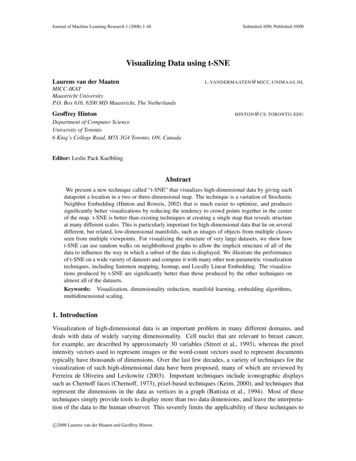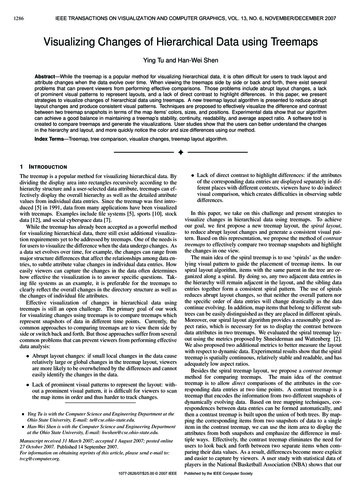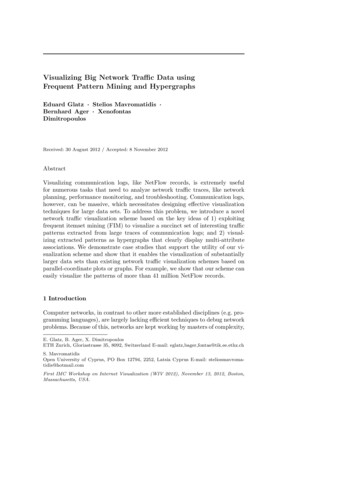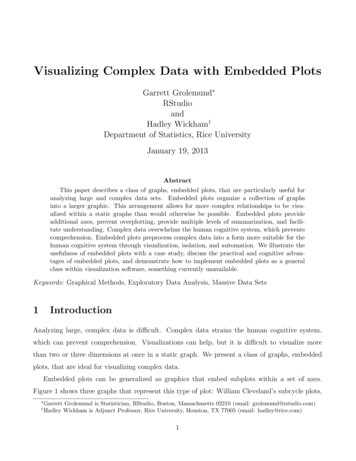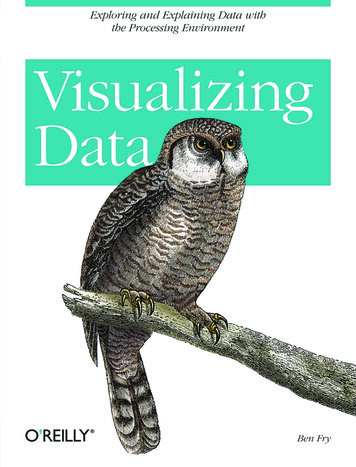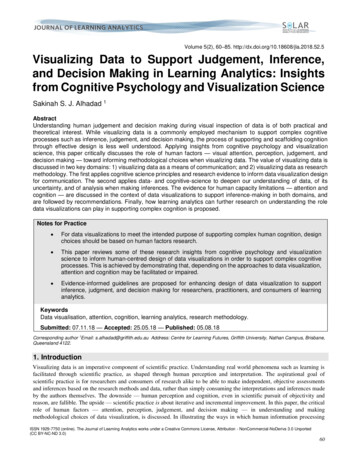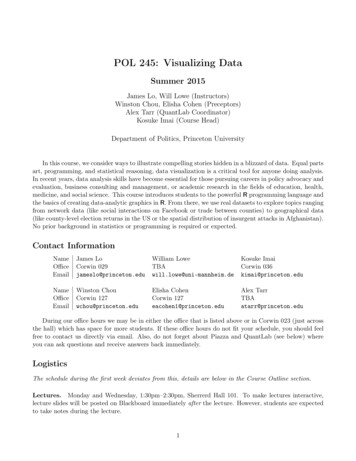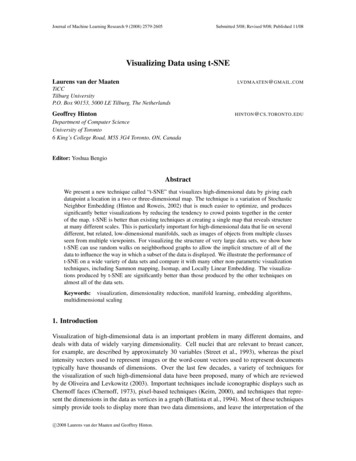
Transcription
Journal of Machine Learning Research 9 (2008) 2579-2605Submitted 5/08; Revised 9/08; Published 11/08Visualizing Data using t-SNELaurens van der MaatenLVDMAATEN @ GMAIL . COMTiCCTilburg UniversityP.O. Box 90153, 5000 LE Tilburg, The NetherlandsGeoffrey HintonHINTON @ CS . TORONTO . EDUDepartment of Computer ScienceUniversity of Toronto6 King’s College Road, M5S 3G4 Toronto, ON, CanadaEditor: Yoshua BengioAbstractWe present a new technique called “t-SNE” that visualizes high-dimensional data by giving eachdatapoint a location in a two or three-dimensional map. The technique is a variation of StochasticNeighbor Embedding (Hinton and Roweis, 2002) that is much easier to optimize, and producessignificantly better visualizations by reducing the tendency to crowd points together in the centerof the map. t-SNE is better than existing techniques at creating a single map that reveals structureat many different scales. This is particularly important for high-dimensional data that lie on severaldifferent, but related, low-dimensional manifolds, such as images of objects from multiple classesseen from multiple viewpoints. For visualizing the structure of very large data sets, we show howt-SNE can use random walks on neighborhood graphs to allow the implicit structure of all of thedata to influence the way in which a subset of the data is displayed. We illustrate the performance oft-SNE on a wide variety of data sets and compare it with many other non-parametric visualizationtechniques, including Sammon mapping, Isomap, and Locally Linear Embedding. The visualizations produced by t-SNE are significantly better than those produced by the other techniques onalmost all of the data sets.Keywords: visualization, dimensionality reduction, manifold learning, embedding algorithms,multidimensional scaling1. IntroductionVisualization of high-dimensional data is an important problem in many different domains, anddeals with data of widely varying dimensionality. Cell nuclei that are relevant to breast cancer,for example, are described by approximately 30 variables (Street et al., 1993), whereas the pixelintensity vectors used to represent images or the word-count vectors used to represent documentstypically have thousands of dimensions. Over the last few decades, a variety of techniques forthe visualization of such high-dimensional data have been proposed, many of which are reviewedby de Oliveira and Levkowitz (2003). Important techniques include iconographic displays such asChernoff faces (Chernoff, 1973), pixel-based techniques (Keim, 2000), and techniques that represent the dimensions in the data as vertices in a graph (Battista et al., 1994). Most of these techniquessimply provide tools to display more than two data dimensions, and leave the interpretation of thec 2008 Laurens van der Maaten and Geoffrey Hinton.
VAN DERM AATEN AND H INTONdata to the human observer. This severely limits the applicability of these techniques to real-worlddata sets that contain thousands of high-dimensional datapoints.In contrast to the visualization techniques discussed above, dimensionality reduction methodsconvert the high-dimensional data set X {x1 , x2 , ., xn } into two or three-dimensional data Y {y1 , y2 , ., yn } that can be displayed in a scatterplot. In the paper, we refer to the low-dimensionaldata representation Y as a map, and to the low-dimensional representations y i of individual datapoints as map points. The aim of dimensionality reduction is to preserve as much of the significant structure of the high-dimensional data as possible in the low-dimensional map. Varioustechniques for this problem have been proposed that differ in the type of structure they preserve.Traditional dimensionality reduction techniques such as Principal Components Analysis (PCA;Hotelling, 1933) and classical multidimensional scaling (MDS; Torgerson, 1952) are linear techniques that focus on keeping the low-dimensional representations of dissimilar datapoints far apart.For high-dimensional data that lies on or near a low-dimensional, non-linear manifold it is usually more important to keep the low-dimensional representations of very similar datapoints closetogether, which is typically not possible with a linear mapping.A large number of nonlinear dimensionality reduction techniques that aim to preserve the localstructure of data have been proposed, many of which are reviewed by Lee and Verleysen (2007).In particular, we mention the following seven techniques: (1) Sammon mapping (Sammon, 1969),(2) curvilinear components analysis (CCA; Demartines and Hérault, 1997), (3) Stochastic NeighborEmbedding (SNE; Hinton and Roweis, 2002), (4) Isomap (Tenenbaum et al., 2000), (5) MaximumVariance Unfolding (MVU; Weinberger et al., 2004), (6) Locally Linear Embedding (LLE; Roweisand Saul, 2000), and (7) Laplacian Eigenmaps (Belkin and Niyogi, 2002). Despite the strong performance of these techniques on artificial data sets, they are often not very successful at visualizingreal, high-dimensional data. In particular, most of the techniques are not capable of retaining boththe local and the global structure of the data in a single map. For instance, a recent study revealsthat even a semi-supervised variant of MVU is not capable of separating handwritten digits intotheir natural clusters (Song et al., 2007).In this paper, we describe a way of converting a high-dimensional data set into a matrix of pairwise similarities and we introduce a new technique, called “t-SNE”, for visualizing the resultingsimilarity data. t-SNE is capable of capturing much of the local structure of the high-dimensionaldata very well, while also revealing global structure such as the presence of clusters at several scales.We illustrate the performance of t-SNE by comparing it to the seven dimensionality reduction techniques mentioned above on five data sets from a variety of domains. Because of space limitations,most of the (7 1) 5 40 maps are presented in the supplemental material, but the maps that wepresent in the paper are sufficient to demonstrate the superiority of t-SNE.The outline of the paper is as follows. In Section 2, we outline SNE as presented by Hinton andRoweis (2002), which forms the basis for t-SNE. In Section 3, we present t-SNE, which has twoimportant differences from SNE. In Section 4, we describe the experimental setup and the resultsof our experiments. Subsequently, Section 5 shows how t-SNE can be modified to visualize realworld data sets that contain many more than 10, 000 datapoints. The results of our experiments arediscussed in more detail in Section 6. Our conclusions and suggestions for future work are presentedin Section 7.2580
V ISUALIZING DATA USING T-SNE2. Stochastic Neighbor EmbeddingStochastic Neighbor Embedding (SNE) starts by converting the high-dimensional Euclidean distances between datapoints into conditional probabilities that represent similarities. 1 The similarityof datapoint x j to datapoint xi is the conditional probability, p j i , that xi would pick x j as its neighborif neighbors were picked in proportion to their probability density under a Gaussian centered at x i .For nearby datapoints, p j i is relatively high, whereas for widely separated datapoints, p j i will bealmost infinitesimal (for reasonable values of the variance of the Gaussian, σ i ). Mathematically, theconditional probability p j i is given by exp kxi x j k2 /2σ2i ,(1)p j i k6 i exp kxi xk k2 /2σ2iwhere σi is the variance of the Gaussian that is centered on datapoint x i . The method for determiningthe value of σi is presented later in this section. Because we are only interested in modeling pairwisesimilarities, we set the value of pi i to zero. For the low-dimensional counterparts yi and y j of thehigh-dimensional datapoints xi and x j , it is possible to compute a similar conditional probability,which we denote by q j i . We set2 the variance of the Gaussian that is employed in the computationof the conditional probabilities q j i to 12 . Hence, we model the similarity of map point y j to mappoint yi by exp kyi y j k2q j i . k6 i exp ( kyi yk k2 )Again, since we are only interested in modeling pairwise similarities, we set q i i 0.If the map points yi and y j correctly model the similarity between the high-dimensional datapoints xi and x j , the conditional probabilities p j i and q j i will be equal. Motivated by this observation, SNE aims to find a low-dimensional data representation that minimizes the mismatch betweenp j i and q j i . A natural measure of the faithfulness with which q j i models p j i is the KullbackLeibler divergence (which is in this case equal to the cross-entropy up to an additive constant). SNEminimizes the sum of Kullback-Leibler divergences over all datapoints using a gradient descentmethod. The cost function C is given byC KL(Pi Qi ) p j i logiijp j i,q j i(2)in which Pi represents the conditional probability distribution over all other datapoints given datapoint xi , and Qi represents the conditional probability distribution over all other map points givenmap point yi . Because the Kullback-Leibler divergence is not symmetric, different types of errorin the pairwise distances in the low-dimensional map are not weighted equally. In particular, thereis a large cost for using widely separated map points to represent nearby datapoints (i.e., for using1. SNE can also be applied to data sets that consist of pairwise similarities between objects rather than high-dimensionalvector representations of each object, provided these simiarities can be interpreted as conditional probabilities. Forexample, human word association data consists of the probability of producing each possible word in response to agiven word, as a result of which it is already in the form required by SNE.2. Setting the variance in the low-dimensional Gaussians to another value only results in a rescaled version of the finalmap. Note that by using the same variance for every datapoint in the low-dimensional map, we lose the propertythat the data is a perfect model of itself if we embed it in a space of the same dimensionality, because in the highdimensional space, we used a different variance σi in each Gaussian.2581
VAN DERM AATEN AND H INTONa small q j i to model a large p j i ), but there is only a small cost for using nearby map points torepresent widely separated datapoints. This small cost comes from wasting some of the probabilitymass in the relevant Q distributions. In other words, the SNE cost function focuses on retaining thelocal structure of the data in the map (for reasonable values of the variance of the Gaussian in thehigh-dimensional space, σi ).The remaining parameter to be selected is the variance σi of the Gaussian that is centered overeach high-dimensional datapoint, xi . It is not likely that there is a single value of σi that is optimalfor all datapoints in the data set because the density of the data is likely to vary. In dense regions,a smaller value of σi is usually more appropriate than in sparser regions. Any particular value ofσi induces a probability distribution, Pi , over all of the other datapoints. This distribution has anentropy which increases as σi increases. SNE performs a binary search for the value of σ i thatproduces a Pi with a fixed perplexity that is specified by the user.3 The perplexity is defined asPerp(Pi ) 2H(Pi ) ,where H(Pi ) is the Shannon entropy of Pi measured in bitsH(Pi ) p j i log2 p j i .jThe perplexity can be interpreted as a smooth measure of the effective number of neighbors. Theperformance of SNE is fairly robust to changes in the perplexity, and typical values are between 5and 50.The minimization of the cost function in Equation 2 is performed using a gradient descentmethod. The gradient has a surprisingly simple formδC 2 (p j i q j i pi j qi j )(yi y j ).δyijPhysically, the gradient may be interpreted as the resultant force created by a set of springs betweenthe map point yi and all other map points y j . All springs exert a force along the direction (yi y j ).The spring between yi and y j repels or attracts the map points depending on whether the distancebetween the two in the map is too small or too large to represent the similarities between the twohigh-dimensional datapoints. The force exerted by the spring between y i and y j is proportional to itslength, and also proportional to its stiffness, which is the mismatch (p j i q j i pi j qi j ) betweenthe pairwise similarities of the data points and the map points.The gradient descent is initialized by sampling map points randomly from an isotropic Gaussianwith small variance that is centered around the origin. In order to speed up the optimization and toavoid poor local minima, a relatively large momentum term is added to the gradient. In other words,the current gradient is added to an exponentially decaying sum of previous gradients in order todetermine the changes in the coordinates of the map points at each iteration of the gradient search.Mathematically, the gradient update with a momentum term is given byY (t) Y (t 1) η δC α(t) Y (t 1) Y (t 2) ,δY3. Note that the perplexity increases monotonically with the variance σ i .2582
V ISUALIZING DATA USING T-SNEwhere Y (t) indicates the solution at iteration t, η indicates the learning rate, and α(t) represents themomentum at iteration t.In addition, in the early stages of the optimization, Gaussian noise is added to the map pointsafter each iteration. Gradually reducing the variance of this noise performs a type of simulatedannealing that helps the optimization to escape from poor local minima in the cost function. If thevariance of the noise changes very slowly at the critical point at which the global structure of themap starts to form, SNE tends to find maps with a better global organization. Unfortunately, thisrequires sensible choices of the initial amo
Visualizing Data using t-SNE Laurens van der Maaten LVDMAATEN@GMAIL.COM TiCC Tilburg University P.O. Box 90153, 5000 LE Tilburg, The Netherlands Geoffrey Hinton HINTON@CS.TORONTO.EDU Department of Computer Science University of Toronto 6 King’s College Road, M5S 3G4 Toronto, ON, Canada Editor: Yoshua Bengio Abstract
